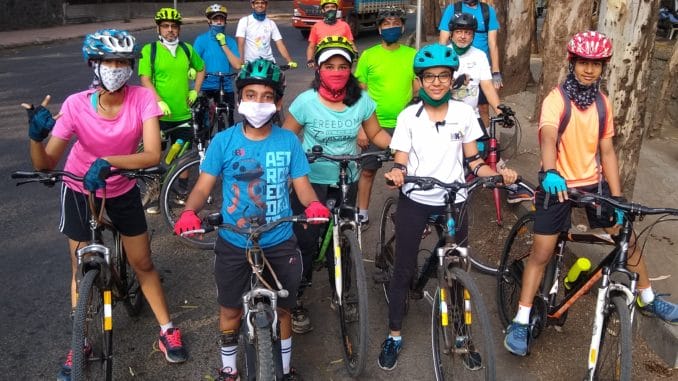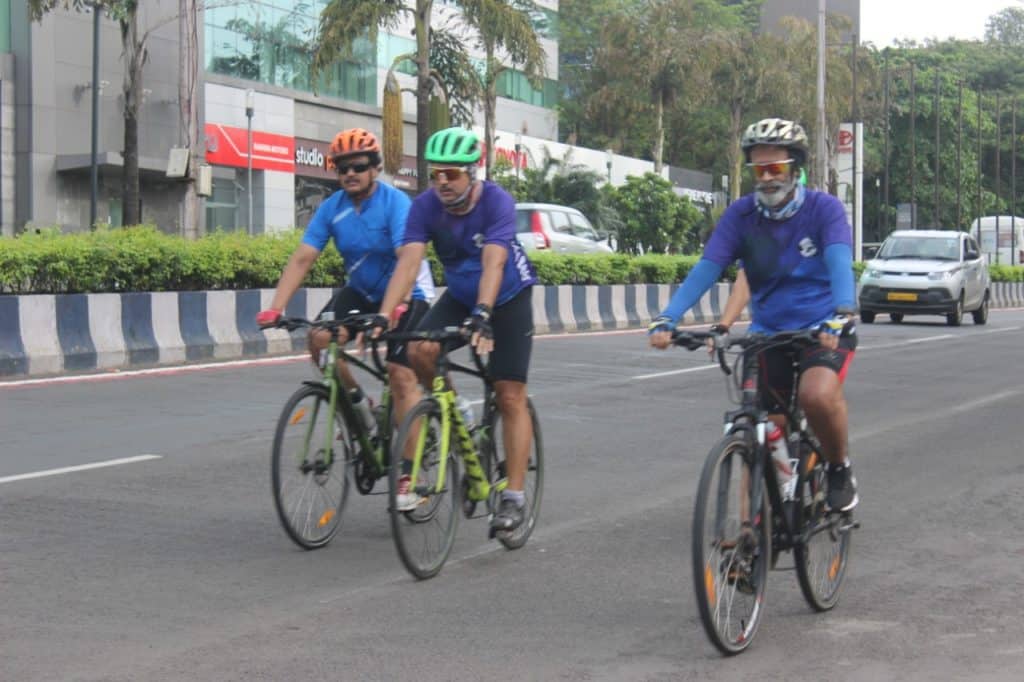I had written this article for Citizen Matters website. Read on...

It’s called Mission Begin Again, Maharashtra’s plans to slowly remove lockdown restrictions and get life back to a new kind of normal. And one directive issued under this Mission, which came into effect from June 3rd, has brought cheer to Pune’s burgeoning cycling community.
Phase I of the Mission lists the outdoor physical activities that citizens can engage in, amongst which cycling features prominently. “People are actively encouraged to use cycling as a form of physical exercise as it automatically ensures social distancing,” reads the directive issued by the state’s department of Revenue and Forest, Disaster Management and Relief and Rehabilitation.
The regular hub of Pune cyclists, the ‘Necklace route’ — covering the area from Savitribai Phule Pune University Road-Pashan lake-Chandni Chowk top — came to life soon after. “Cycling is a fun, enjoyable group activity and yet you don’t come very close to each other,” said Rajeev Khandekar, a businessman, who prefers leisure cycling over competitive riding.
The ‘City of Bicycles’, one moniker of old Pune, is well deserved because of its topography. The city and its surrounding areas, with its flat roads, hillocks and ghat sections ensures a variety of terrain that can be explored by beginners, fitness freaks, week-end cyclists and others.
“To gain speed, we need flat roads and the Pune-Ahmednagar Road is a good example,” said Rohit Dandekar, who serves in the Merchant Navy. “For climbs, we can go to Khandala ghat and Sinhagad fort. If we want to do smaller climbs, then the new 6-km Katraj tunnel road is good option. There are numerous forts and hillocks. Depending on your practise intensity, you can make use of any of the terrains. Even the Pune-Bengaluru Highway is good for cycling. At least we haven’t been scared off the roads by bigger vehicles”.
“It’s better to ride in groups on highways,” cautioned Nikhil Kale, an IT-Robotics engineer. “Often heavy vehicles like trucks and trailers brush past you. We now share live location on WhatsApp with our buddy riders so that we can keep track of each other.”
On the city roads, Nikhil says the cycle is the best mode of commute. “My office is about 10 km from where I stay. I cycle to work, twice or thrice a week, covering the distance in 30-40 minutes. In peak traffic during the evening, a cycle moves much faster than a car which takes 45-60 minutes to cover the same distance.” Kale was preparing for the Copenhagen Ironman competition scheduled for August this year but which has been called off because of the pandemic.
Cycling infrastructure incomplete
Maitreyi Bokil, a Sports Nutritionist and Exercise Physiologist, whose dad is a trauma surgeon, was not permitted to cycle as a kid. “I bought my first cycle last year, when I signed up for Goa Ironman 70.3. Now I have overcome my fears, though it would be great if there were no stray dogs on the roads.”
Ironman is a brand and it holds triathlon events worldwide. The first 70.3 Ironman in India was held in Goa in October 2019. It includes 1.9km swimming in open water body like sea, lakes etc, 90 km cycling and 21.1 km running – all events have to be completed by the participant one after the other within a cut off time period. The full Ironman includes 3.9km swimming, 180 km cycling and 42.1 km running. The event in Goa was half Ironman since the duration for the events was half of the full Ironman. But the event is known as 70.3 because that’s the total distance of the three sports in miles. The finishers are called Ironman.
The enthusiasm of these bicycle enthusiasts is contagious. But Pune still has some way to go before it can create a safe, city-wide cycling infrastructure. Well laid out cycle tracks were part of the Comprehensive Bicycle Master Plan approved by the PMC in December 2017. Simultaneously, a Public Bicycle Sharing (PBS) plan was also approved.
A citywide network of cycle tracks and painted cycle lanes was planned and the Urban Cycling Design Guidelines were approved as a part of the cycle plan. Even a bicycle department was created and MoUs were signed with various PBS vendors. However, the shared bicycles, available for nominal rent, were mostly withdrawn by 2019.
Mobike, Ofo, Pedl and Yulu were the vendors for the Public Bike Sharing programme. Mobike has shut down all international operations except in China. At the moment, Yulu is the only operator in the city in select pockets. Vandalism and the increase in price for bike sharing were some of the reasons why the experiment didn’t succeed.
“I noticed that some users were indisciplined,” said Khandekar who had availed the shared bicycle service when it was functional. “They wouldn’t park the cycle at designated parking lots. I heard of an incident where the lock of one cycle was thrown into the front yard of a bungalow and the cycle was stolen. It was a good initiative, but citizens misused it.”
Of the proposed 300 km of dedicated cycle tracks that is to come up in the city, only 100 kms, in different city segments, is ready as of now. The lockdown has further delayed creation of more cycle tracks. “The state government has said that only 33 per cent of the budget can be spent this year on salaries and only on emergency work,” said V G Kulkarni of PMC’s Road Department, under which the cycle department comes.
Poorly designed
But even before the lockdown stopped all activity, the manner in which the cycle tracks were laid out disappointed the city’s growing cycling community. “The tracks that have come up in parts of the city are not equipped for the cycles that we use,” said Kaustubh Dandekar. “I think the civic body has good intentions, but there are certain aspects which are not conducive for cyclists,” added Bokil.

For instance, cycling tracks on footpaths have smaller cement bollards which were erected as a part of the new road design under Pune Smart City Development Corporation Ltd. They restrict two wheelers from riding on footpaths and cycle tracks. But the cyclists feel that there should be more space between the bollards. Right now, either the handlebar or the pedals get caught between the bollards. Cyclists then have to get off and cross over and then continue cycling.
“Riders often have to get down and hoist their cycle up and cross over those small columns,” said Rohit. “Serious cyclists don’t want to lose their momentum and it becomes difficult to negotiate the tracks. We want to share our inputs with the authorities instead of just posting pictures and submitting petitions.”
In his childhood, Kaustubh remembers renting cycles for 5 paisa, 10 paisa and 25 paise depending on their frame size. “To own a cycle was a matter of prestige then. Now, we have many modes for transportation, but I still prefer to cycle, for exercise, enjoyment or for taking part in competitions. I have teamed up with my brother and friends to take part in different competitive events like Deccan Cliffhanger and Ultra Spice race.”
One unintended fallout of the cycling tracks is the inconvenience it is causing to pedestrians. Pune was one of the examples recently mentioned in the Union Urban Development ministry’s directive to states to create more pedestrian and bicyle-only spaces. Construction of the Pune Metro includes widening of footpaths.
A case in point is the arterial Fergusson College Road which has now become narrower with wide footpaths, including cycle tracks, new bus stops, benches and all, lending a lazy vibe to the otherwise crowded road, teeming with traffic of two-wheelers, buses, autorickshaws and cars.
“Whenever we step out to walk on FC Road, I find that vendors have taken over the footpaths,” says Meenal Kaore, who stays at Deccan Gymkhana. “In fact it’s difficult to spot where the cycle track begins or ends.”
“I don’t know from where the cycle track begins or where it ends…it’s not continuous,” added Ketaki Gadre a resident of the area.
So hope remains that post-pandemic, Pune will get back its old sobriquet of “City of cycles”
Comments
Post a Comment